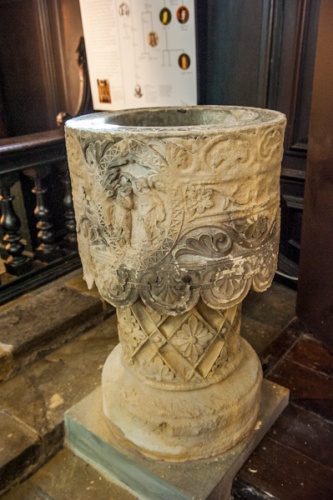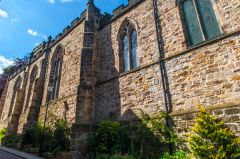
The Durham Museum is a fascinating museum of local history covering Durham and the surrounding area. The museum is housed in the redundant medieval church of St Mary-le-Bow, a short stroll from the Cathedral and Castle.
UPDATE: Durham Museum is temporarily closed to allow for essential refurbishment and repair. We will update this page when the museum reopens. In the meantime, please do NOT make plans to visit.
St Mary-le-Bow Church
Durham Cathedral was a monastic church, so the city that surrounds it was divided up into separate parishes, each with its own church. St Mary-le-Bow was the parish church for the North Bailey area of Durham. Its name comes from a medieval arch, or 'bow' connecting the west tower to the city's fortification wall.
The arch, the tower, and a large section at the western end of the church collapsed in 1635. The building lay in ruins for 50 years until in 1685 the Dean and Chapter of the Cathedral and the Bishop of Durham gave money to help rebuild it.

The church we see today is this 17th-century building with the addition of a 1702 tower. Inside the church, you can see beautiful oak furnishings including a 15th-century timber roof, an altar rail installed in 1705 and a rood screen added two years later in 1707. Finely carved panelled wainscotting was installed in 1731 with a west gallery and vestry in 1741.
The church was made redundant in 1968. It was restored and reopened as the Durham Museum and Heritage Centre in 1976.

The Museum
The museum tells the fascinating story of Durham and its powerful Prince Bishops, who ruled the north-east of England like feudal monarchs. Learn about the origins of Durham Castle and Cathedral, and how the Cathedral became such an important destination for pilgrims.
The museum looks at life in medieval Durham, where Scottish raids were a constant menace. Exhibits look at the powerful Neville family of Raby and Brancepeth, who counted among their members King Edward IV and his brother King Richard III.
One of the museum's treasures is a set of four stained glass windows depicting leading members of the Neville family including Cecily Neville and Richard, Duke of York, the parents of Edward IV and Richard III. The other two windows show Ralph Neville, Earl of Westmorland, and his wife Joan Beauford. The windows were designed by the Victorian artist William Collins in 1824.

The museum also looks at industries that made Durham famous; carpet-making, brewing, mustard manufacturing, and organ-making. See a model of the city in medieval times and another model of the Market Place in the Victorian period. Another highlight is a reconstruction of a grim 19th-century prison cell. See a sedan chair dubbed 'the Death Chair', used to carry sick boys at Durham School to the infirmary.
Until 1972 Durham had its own Chancery Court, one of the last vestiges of the Prince Bishops independence from royal rule. See the 17th-century Chancellor's bench with models of a judge and clerk seated under an ornate Prince Bishops' coat of arms.
Learn about prominent local characters like Stephen Kemble, a 19th-century theatre manager who brought many of the most famous actors on the London stage to Durham.

The museum has a popular brass rubbing centre and a lovely garden (open weather permitting) which is home to two sculptures by the famous sculptor Fenwick Lawson.
Don't confuse the Durham Museum with the World Heritage Site Visitor Centre on nearby Owengate, which is housed in a restored 19th-century almshouse.
Getting There
The museum stands on the corner of Bow Lane and North Bailey, opposite the east end of the Cathedral. There are several public car parks nearby including one beneath the Prince Bishops Shopping Centre, two under the Gates Shopping Centre, and one at the Walkergate Complex. Alternately, do what we did and use the excellent park and ride system.
About Durham Museum
Address: North Bailey,
Durham,
County Durham,
England, DH1 3ET
Attraction Type: Museum
Location: At the corner of bow Lane and North Bailey. There are several public car parks within walking distance.
Website: Durham Museum
Location
map
OS: NZ274421
Photo Credit: David Ross and Britain Express
POPULAR POSTS
HERITAGE
 We've 'tagged' this attraction information to help you find related historic attractions and learn more about major time periods mentioned.
We've 'tagged' this attraction information to help you find related historic attractions and learn more about major time periods mentioned.
Find other attractions tagged with:
NEARBY HISTORIC ATTRACTIONS
Heritage Rated from 1- 5 (low to exceptional) on historic interest
Durham Cathedral - 0.1 miles (Cathedral) ![]()
Durham Castle - 0.2 miles (Castle) ![]()
Durham Town Hall - 0.2 miles (Historic Building) ![]()
Crook Hall - 0.6 miles (Historic Building) ![]()
Finchale Priory - 3.3 miles (Abbey) ![]()
Brancepeth Castle - 4.2 miles (Castle) ![]()
Houghton-le-Spring, St Michael and All Angels - 6.3 miles (Historic Church) ![]()
Binchester Roman Fort - 7.9 miles (Roman Site) ![]()
Nearest Holiday Cottages to Durham Museum:
Witton Gilbert, Northumberland
Sleeps: 6
Stay from: £950 - 3630
More self catering near Durham Museum









